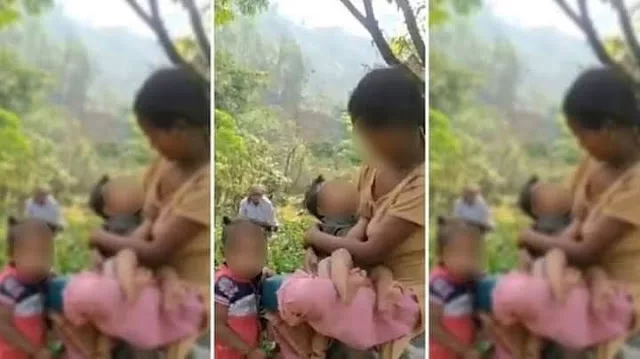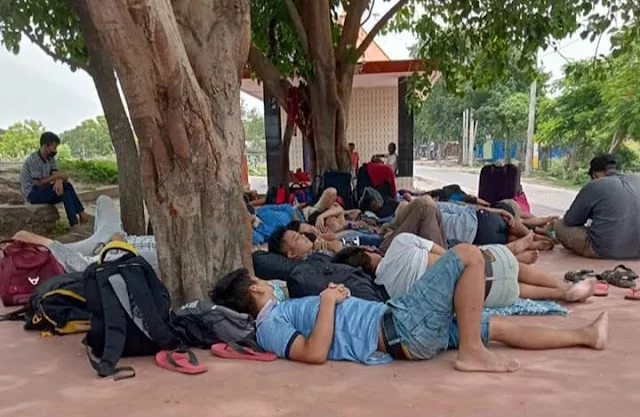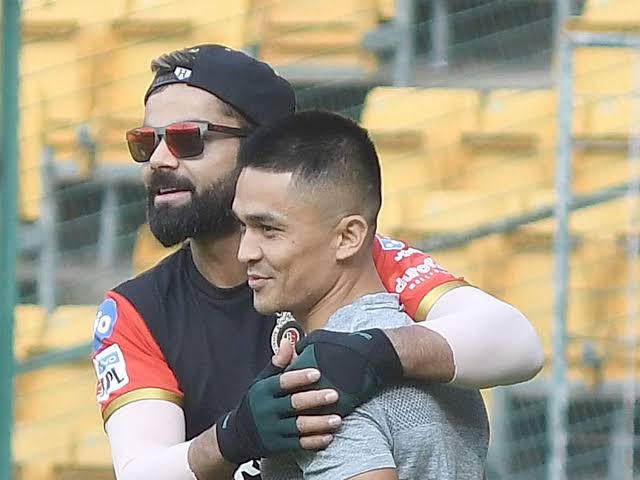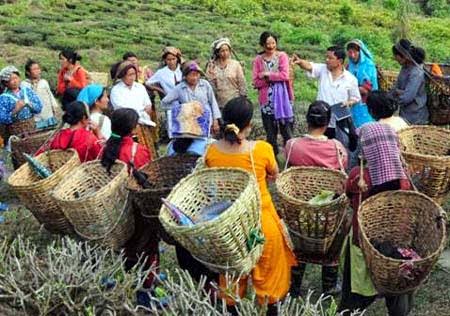Name: Niranjan
Son of: Daria Singh
Caste : Chhetri
Age: 35 years
Village: Tikuamoh
Zilla: Hardoi
Status: Hindustani
Subedar is just the designation under Manipuri Army given by Jubraj Bir Tikendrajit.
Name of a person is just a naming word which may or may not carry any meaning. However, names in Gorkha society are often based on the life style and habit of a person. As such, name Daria is a lifestyle based name meaning a person who keeps beard in Nepali. Moreover, there are certain surnames of ‘Chhetri’ caste which end in ‘ria’. For instance, ka-dara. Further, ‘Singh’ title is common to many Hindu society including Gorkha. In fact, in UP and Uttarakhand it is difficult to distinguish Gorkha from Rajputs as many of them (Gorkha) write ‘Singh’ as their title instead of caste ‘Chhetri’. Therefore, common and not a common name of a person belonging to a particular community does not arise and this may not provide any clue to the identity of a person.
 |
| Subedar Niranjan Chhetri – Photo awaited |
Gorkhas are basically a Hindu society having caste heirarchical system prevalent among themselves and broadly divided into Janailaune (holy cord wearer) and nalagaune (holy cord not wearer). Vedic model of Varna introduced by migrant Indian Rajpoots in Nepal could not accommodate diverse profession based ethnic communities and therefore,vedic model is not strictly followed by the Gorkhas. Bahun, Chhetri Vaishya and Sudra is the Gorkha version of Sanskrit Vedic system of classification-Brahmin, Kshatriya, Vaishya and Sudra. Gorkha from the very beginning of vedic age maintained their unique identity of writing ‘Chhetri’ as their caste at the end of a name but not Kshatriya. There is no dispute on the usage of ‘Chhetri’ and ‘Kshatriya’ by a particular community although the caste ‘Chhetri’ may have been derived from the sanskrit word ‘Kshatriya’. Both of them more or less carry the same meaning but usage of the word is different for different communities. Therefore, ‘Chhetri’ is the genuine caste of Gorkhas only whose mother tongue is Nepali . ‘Chhetri’ means ‘Chhetri’ only and NOT ‘Chhetri means ‘Kshetri’ (Rajpoots) or ‘Kshatriya’ in the name of a person. However, some Gorkhas write Kshetri/Chetri/ Chettri/Chhettri, etc which are nothing but the distorted form of the word ‘Chhetri’ and they write so due to their ignorance. ‘Chhetri’ is pronounced as ‘chhetri’ only and it is the correct spelling of the word but the use of ‘i’ and ‘y’ in the spelling of ‘Chhetri’ or ‘Chhetry’ is optional. Even in those days, British recognised as many as 12 warrior caste of Gorkhas of which ‘Chhetri’ is one of them. They don’t make mistake in recording the correct spelling of ‘Chhetri’. Therefore, name Niranjan Chhetri recorded by H Maxwell, the Chief Political Officer during the trial of the accused is chhetri of Gorkha origin only. Had it been recorded as Niranjan Kshetri/Kshatriya, he may or may not be a Gorkha. Further, all Hindustani Rajpoots in Northern India beyond Bengal pronounced ‘Kshetri’ as ‘Chhetri’ is something new and not heard. No Rajpoots in the country write ‘Chhetri’ as their caste and pronounce kshetri as chhetri. Therefore, caste ‘Chhetri’ is only and only used by people belonging to the Gorkha community. One may find the people using caste ‘Chhetri’ in Nepal, India, Myanmar, China, Bhutan, and recent past evicted ethnic Bhutanese refugees settled in USA, Canada, Denmark, Australia, New Zealand and Switzerland under the aegis of United Nations High Commissioner for Refugees (UNHCR).
Casual look on the face of a person carries difference impression to different people as regard their identity and it may or may not be useful in the identification of a person. Gorkha society is a complex society and their racial variation is from caucasoid to mongoloid having large variation within the two extremes. Therefore, casual look not at all serve the purpose of identification at least in the Gorkha society. However, traditional attire/apparel of a community carry a definite clue in the identification of a person belonging to a particular community if a person (s) appear/pose with traditional garments in a special occasion such as photography with VIP’s. In such a occasion one wish to exhibit one’s traditional attire to reflect his/her identity in order to showcase their unique identity to others and their own community as well. Subedar Niranjan did the same thing here. Look at the traditional Gorkha cap called Birke Topy on his (Niranjan’s) head posed with his supreme commander Bir Tikendrajit (it is not clear in the photo published in the article). There are two types of traditional caps found in Gorkha society. One is Birke Topy (meaning cover of a container) and the other is Bhatgaunley Topy (Averest cap) which is modern and more common. Wonderful historical fact attached to this cap but less known to people which in gist are as follows: At the peak of Anglo-Nepal war, particularly during Khalanga war at Nalakata near Dehradun, British Army cut off the water supply to the bunkered Gorkhas fighting against the British were forced to come out of the bunker in a do or die situation with a war cry “Jai Gorkha” and flashing ‘Khukuris’. British Army run away leaving behind a wounded British Army officer named General Federic Young. When he was asked “why didn’t you run away”, British officer replied “I don’t come so far to run away”. Hearing this Gorkha Army took care of him with great sympathy and kindness. This has made the everlasting impression of the Gorkhas in the mind of the British officer and Britishers became the best admirer of Gorkhas and in returned he strongly recommended the Gorkhas for their mass recruitment in British Army. When he (probably Federic Young) went to Tanahun district of Nepal- the birth place of Adi Kabi Bhaubhakta Acharya, 560km from Kolkata, with a mission to recruit Gorkhas, he found everyone wearing Birke Topy. Then and then he recommended the Birke Topy for the Gorkha soldiers in the British Army. This is how Birke Topy came into being in the British Army and only traditional Gorkha put this cap during special occasion unlike Bhatgaunley cap which is commonly worn by others also at any time they like. Subedar Niranjan also did the same by exhibiting his traditional Birke Topy on his head to identify himself as Gorkha. If any one has doubt on the Birke Topy he put on his head, simply compare with the cap of a soldier resisting a Nupilal member on the top of Nupilal Memorial Complex. The soldier may be Gorkha or not but the cap is a bit modified Gorkha cap called Birke Topy.
Hardoi in UP is not an unknown place to Gorkhas. Being a Hindu pilgrimage centre, many devotees from Nepal pay visit as pilgrim. Many came in search of sundry jobs. Further, large army based centre nearby Fatehgarh attracts Gorkha either from India or Nepal to meet their near and dear ones. This is supported by the fact that 9th Gorkha Rifles raised as Fatehgarh Levy as early as 1817- 1819 and Mianpuri Levy in 1819-1824. Lucknow is the Regimental Centre of 11 Gorkha Rifles. In fact, Lucknow is the learning centre next to Banaras for the Gorkhas right from the British days and the border between the two countries was never closed even during the Mughal period. If you look at the historical and cultural greater Nepal, it is wrong to say that Gorkhas were present only in Terai and Banaras in those days. Pages of history speaks the waves of migrants from India to Nepal and vice-versa even in olden days. Thus, given situation indicates that existence of pocket of Gorkhas houses, not necessarily a village around Hardoi in those days cannot be ruled out.
Recorded age of Subedar Niranjan was 35 years at the time of trial (5th May, 1891) and he was an ex-British soldiers. Minimum age (17 or 18 years ?) requirement for recruitment in Army suggest that he is recruited sometime in between 1872- 1876. Further, it is not necessary that he must have recruited at Hardoi only. By this time, particularly after the Sepoy Mutiny recruitment policy particularly the class composition must have been changed and British preferred to have mixed class composition of army in order not to recur the Sepoy Mutiny. In fact, after the Sepoy Mutiny Gorkhas were more loyal to British than others. Hence, inclusion of few Gorkha soldiers in the 34th (Fatehgarh) Regiment of Bengal Native Infantry,particularly in its mixed company cannot be ruled out. Interestingly, the regiment recorded in the statement of accused was 34th Bengal Native Infantry but soon after Mutiny this regiment was disbanded and changed to 34th (Fateggarh ) Regiment of Bengal Native Infantry in 1864.Subedar Niranjan does not meet the age requirement to be recruited in the 34th BNI as per the chronology of this infantry (FIBIwiki). Therefore,it is left to the interested scholars to establish the missing link.
Yes, there was a stiff opposition from the then king of Nepal for the recruitment of Gorkhas in the British Army in early days. But this did not last long because of the British tactics to lure the Gorkha youths with some kind of attractions through the middleman, agents and others for recruitment into their Army. Out of sheer compulsion and economic necessity , besides other push factors, Gorkha youths considered it as an opportunity and crossed into the British territory and recruited. Moreover, in the latter part, Nepal helped British in consolidating its hold in India. Bengal Army was highly disciplined and strict and they were not allowed to cross the border (though it was open) but their recruitment party stationed in the border recruit the Gorkha youths who offer voluntarily. It is my probable gesture that some kind of arrangement might have been made as regard the Hindustani or Gorkha status of the unfair recruits during early period of Segowlee Treaty (1815). Further, from the historical Greater Nepal perspective, it was every likelihood that many Gorkhas might have entered into the British Army as Hindustani. For instance, ‘Naya Muluk’ in the Central Terai bordering UP gifted by the Bitish after the Nepali Prime Minister Jangbahadur Rana helped the British in crushing the Sepoy Mutiny in Lucknow. Moreover, any Gorkha soldier whosoever face a crime be it POW, waging war against British, conspiracy and instigation ,etc, they always make the country proud by admitting that they are Hindustani first and their identity as Gorkha next. For instance, Durga Malla- the great freedom fighter who waged war against British for which he was hanged in Red Fort, Delhi and Thapa – POW of 1962 Chinese war admitted that they were Hindustani despite the fact that they belong to Gorkha Community. Further, during this long span of years between 1st recruitment of Gorkhas into British Army (1815) to 1872-74 (possible recruitment year of Subedar Niranjan) nearly little over 50 years, 2nd and 3rd generation of Gorukha descendants was possible to appear. Therefore, it may be that Subedar Niranjan belong to 2nd generation Gorkha descendant of Gorkha soldier and he might have given priority for entry into the Bengal Army as Hindustani. This was not necessary but just to show the relation between Hindustani & Gorkha.
As the first part of the identity related statement of the accused is sufficient to establish his identity, analysis of his service related statements is not very important. However, getting the post of Subedar in Manipuri Army must have a definite Cacchar connection without which it was not easy to get that coveted post and that too to a stranger within a short period of time to become a ring leader of Bir Tikendrajit. Manipuris and Gorkhas must have known to each other since the inception of Assam Light Infantry and Syllhe Light Infantry where both the groups were present and posted in different locations of British Cacchar Province. Further, pages of history tell us that settlement process of Gorkhas and their families started as early as 1830 and by 1832 there were good cultivation of dhan was noticed which was earlier jungle in Cacchar as per the joint report on Assam by Captain Francis Jetkins and Lieutenant Robert Pemberton in August, 1832. This is further supported by the fact that Mr. Man Bahadur Limbu (MB Limbu) – an employee of post office in Cacchar who used to bring letters and DAK for Manipur by clearing inaccessible mosquito infested jungle with his khukuri for which MB road from Jiribam to Bekra-26km has been named after his name in honour of his bravery is well known to every older generation of Manipur seemed to have been from that Cacchar settlement Gorkha village. In addition to this there is a village called Hardoi near Haflong in Dimasa areas and also Hamdoi and Tipomua village under Golaghat and Jorhat district of Assam respectively. I mentioned all these because Hardoi of UP was not mentioned in his trial statement.
No matter where he comes from. Caste ‘Chhetri’ in his name and traditional Gorkha Birke Topy on his head are more than sufficient to justify his established identity as Gorkha recorded by the Manipur State Archive. Possibly and not necessarily, he must be a descendant of 9th Gorkha Rifles soldiers of British India as it traces its origin nearby Hardoi. Possibly, as second generation Gorkha soldier descendant, he entered into the Army as Hindustani. Crime related statements of the accused is not necessary for the establishment of his identity and therefore, other doubts raised in the article are secondary and do not merit clarification and justification. He served Manipur and died for Manipur as Gorkha Hindustani.
The writer is Professor, Manipur University & Ex- visiting scholar, University of Washington, USA and he can be reached at [email protected]
Source: thesangaiexpress





